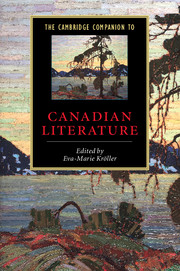Book contents
- Frontmatter
- Introduction
- 1 Aboriginal writing
- 2 Francophone writing
- 3 Exploration and travel
- 4 Nature-writing
- 5 Drama
- 6 Poetry
- 7 Fiction
- 8 Short fiction
- 9 Writing by women
- 10 Life writing
- 11 Regionalism and urbanism
- 12 Canadian literary criticism and the idea of a national literature
- Further reading
- Index
- Series List
11 - Regionalism and urbanism
Published online by Cambridge University Press: 28 May 2006
- Frontmatter
- Introduction
- 1 Aboriginal writing
- 2 Francophone writing
- 3 Exploration and travel
- 4 Nature-writing
- 5 Drama
- 6 Poetry
- 7 Fiction
- 8 Short fiction
- 9 Writing by women
- 10 Life writing
- 11 Regionalism and urbanism
- 12 Canadian literary criticism and the idea of a national literature
- Further reading
- Index
- Series List
Summary
Imagined geographies
Canada's vast distances, natural barriers, diverse patterns of settlement, and locally specific histories have led many commentators to see regionalism as a defining feature of Canadian culture. George Woodcock articulated a widely held view when he asserted that Canadian literary traditions have always been fundamentally regional, developing differently in different parts of the country. In the preface to The Bush Garden (1971), Northrop Frye stressed the importance of regions to the creative imagination, arguing that an imagination conditioned by prairie stretching to the horizon would develop differently from one shaped by the huge mountains and trees of British Columbia or by the churning sea around Newfoundland. According to these influential literary critics, the experience of living in a vast country of strikingly different landscapes has inevitably led Canadian writers to assert a primary imaginative allegiance to specific regions rather than to the whole country.
- Type
- Chapter
- Information
- The Cambridge Companion to Canadian Literature , pp. 241 - 262Publisher: Cambridge University PressPrint publication year: 2004
- 2
- Cited by

